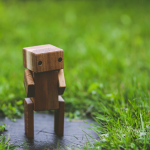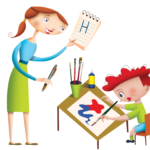
27 Jun Looking at Literacy: Get It Write From The Start
In the beginning, there will be a lot of scribble says Joelie Hancock – round and round, repeated strokes, spots or jabs at the paper. This play is very important. It is the child’s way of experimenting, finding out how things work and gaining control of the materials.
When toddlers grab a pencil and make their first marks on paper, they are on their way to writing. Already they have realised that making marks is a significant activity in the world, and they want to do it. If they say ‘I’m writing my name!’ or ‘My shopping list!’ they have also made the connection between marks on paper and words. Their amazing little minds have twigged that marks on paper can mean something.
To make such connections, children must be around adults who write. It helps if the writer also makes clear what the writing is for: ‘It’s a card to wish Grandma a happy birthday’, ‘It’s a list so we remember to buy everything we need’ or ‘It’s a note to let Daddy know when we’ll be home’.
Children model themselves on the people they care about. Preschoolers who see writing used for real purposes will expect and want to learn to write. (It’s important that they see both mothers and fathers writing so that they don’t come to think of writing as a purely female or purely male activity.)
At first, pencils are difficult to handle and the lead is prone to breaking
Understanding what writing is for and wanting to write are important. But to develop the skills of writing, children also need the tools and opportunities to learn to make marks. Controlling a texta, crayon, pencil or piece of chalk so that it makes the marks they want involves years of practice.
To begin practising they need large pieces of plain paper and a table where it doesn’t matter if they zoom off the edge of the paper occasionally. At first, pencils are difficult to handle and the lead is prone to breaking; crayons or textas, with their bright colours, quickly become favourite drawing tools.
Children need guidance and supervision from the beginning so that they know which end to hold, not to eat the crayon or put the texta in their mouth (or eye), to try to stay on the paper and to finish with one piece of paper before starting on another. With the right encouragement, two-year-olds can even learn to put the tops on textas – at least most of the time.
Hand-eye coordination and fine finger control is needed to shape circles and place strokes exactly where they are wanted in drawings and writing. This control also develops in play with small toy animals, beads, computers, playdough, blocks and jigsaws.
At first, the distinction between drawings and writing isn’t clear to them
As children gain control over the marks they make, they may tell you what they have drawn, although the pleasure of making the marks is often enough. At first, the distinction between drawings and writing isn’t clear to them. You can help with that distinction when you read to them.
You can begin a book by talking about the picture on the cover, then point to the title: ‘Now what does the writing say?’ Run your finger under the words as you say them, and as the child begins to know some of the letters, you can point them out: ‘Look, that letter’s in your name! K for kitten and K for Katie’.
When the child is interested in your writing you can help make the connection between letters and sounds and show them how to write. Letters in the child’s name and in those of family members are good, to begin with.
Tell them what you are writing as you write the words – ‘To Uncle Tim’ – and sound out the letters as you write a name – ‘J-A-S-O-N’. The child might then try writing some of the letters or write over your printing. Allow for large letters and don’t worry at all if the letters are upside-down or back-to-front at first. There’s a lot for little fingers and minds to master all at once.
They will need someone to tell them what the sounds are and to share in their success when they get them right
Playing with letter blocks, alphabet books, magnetic letters or a keyboard can help young children become familiar with letters and their associated sounds. They will need someone to tell them what the sounds are and to share in their success when they get them right. While there are electronic games that can match sounds with letters and give feedback, that’s not the same as an enthusiastic adult who shares the excitement of a child’s achievements and makes sure that he or she associates letters and writing with pleasure and success.
An appreciation of what writing is for, plenty of opportunities to draw and write, and a growing knowledge of the letters of the alphabet are the three aspects of learning to write that many children in our society bring to school. While parents and caregivers can play a large part in that learning, it is critical that young children come to these understandings and develop these skills in their own time.
Joelie Hancock is an author and has been a literacy education consultant who lectured in language and literacy education at Flinders University for more than 20 years.




